MIS 3 Gleysols and Histosols in the center-north


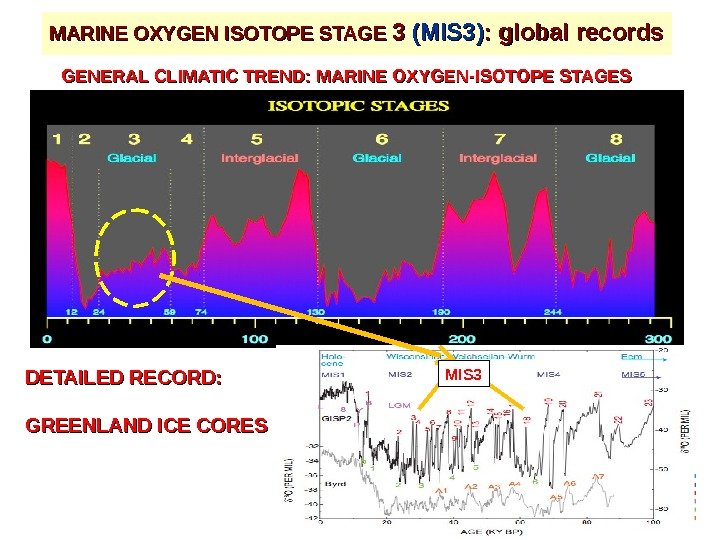
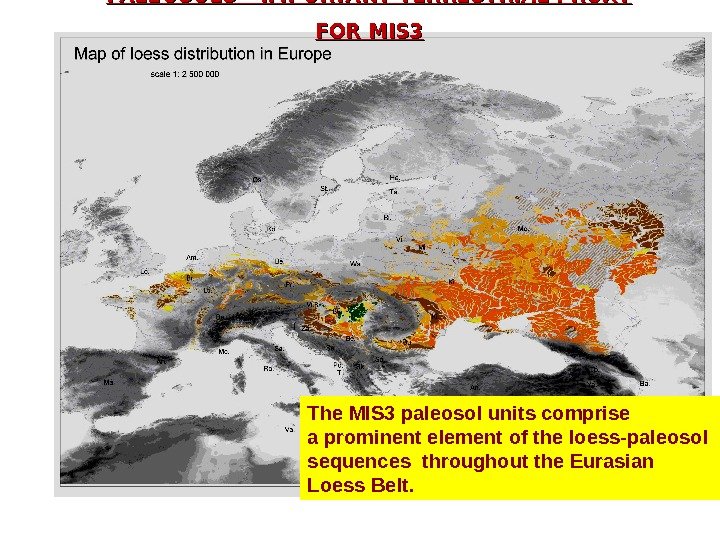
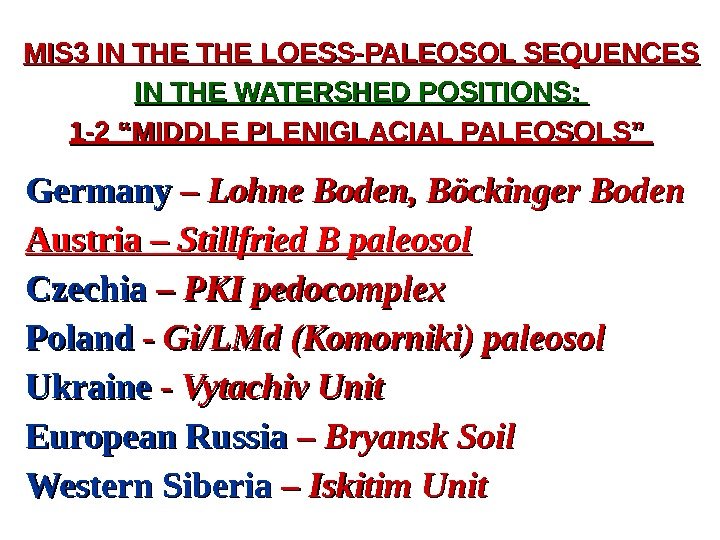

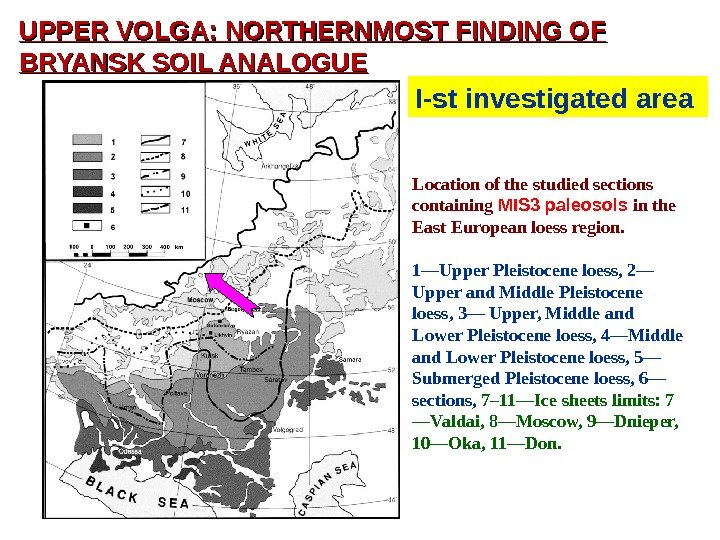

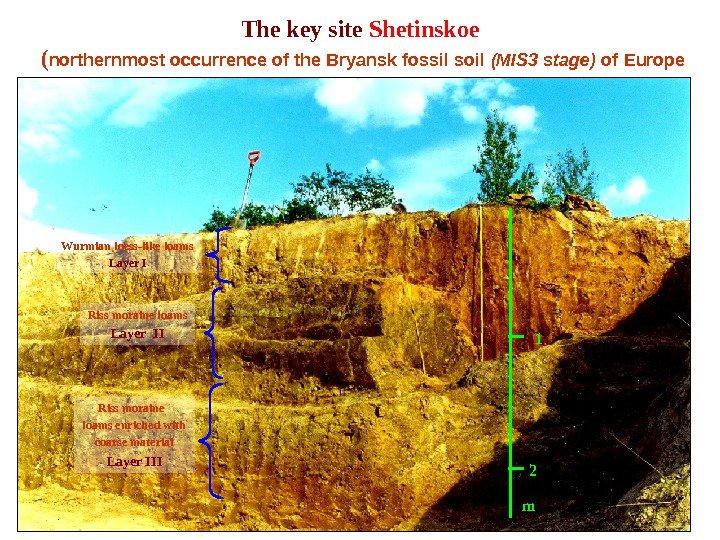
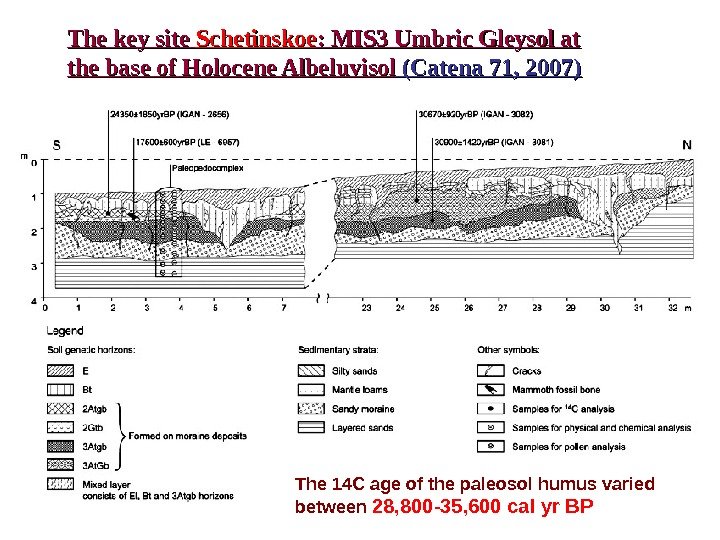

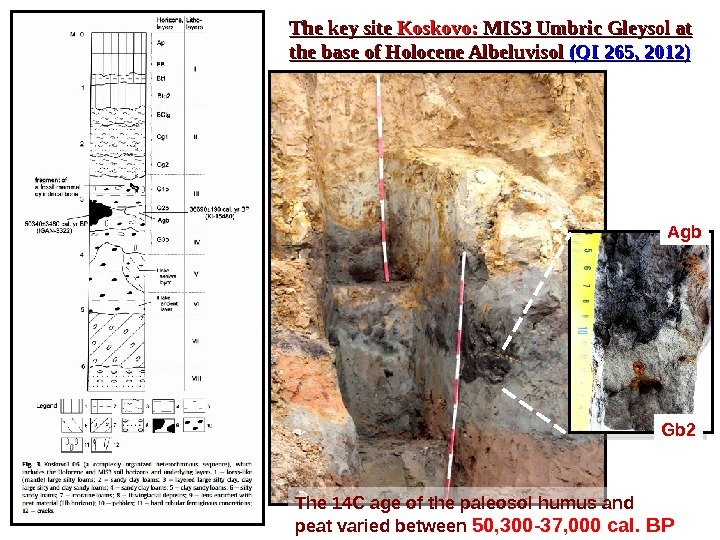

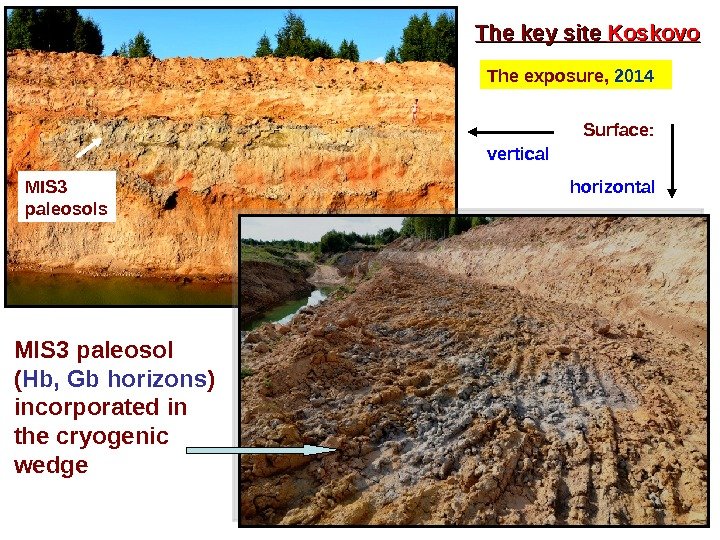
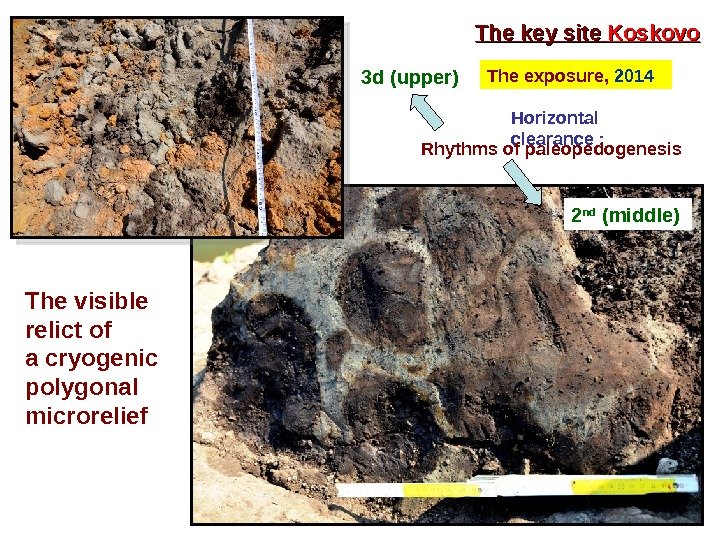

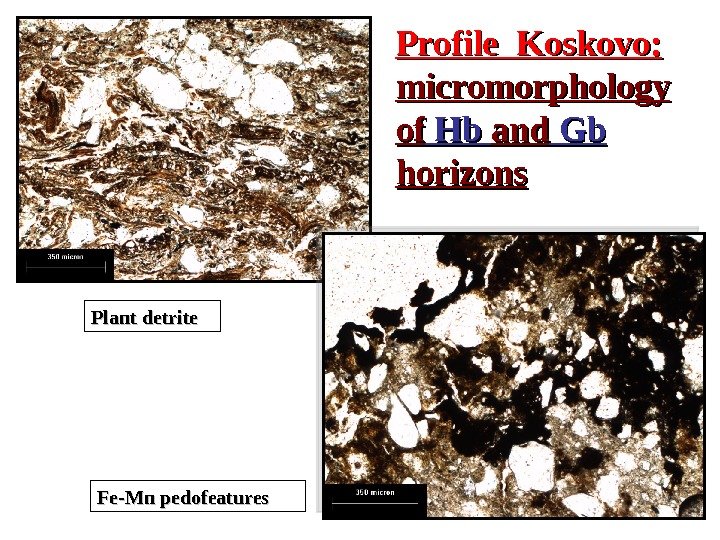

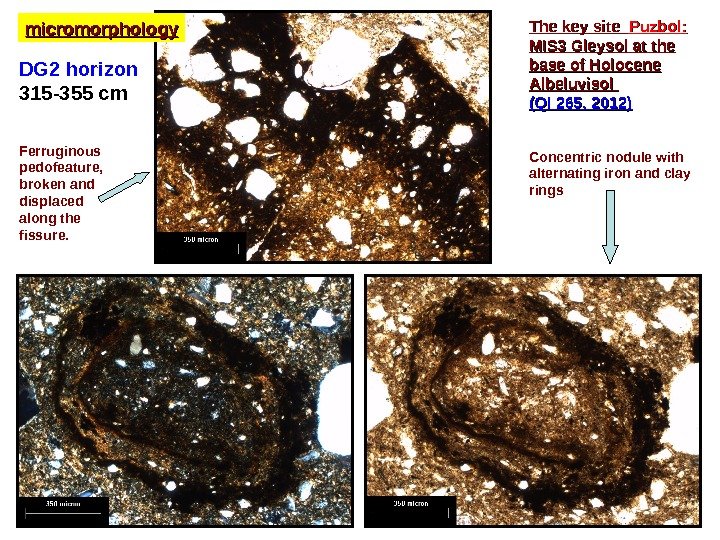
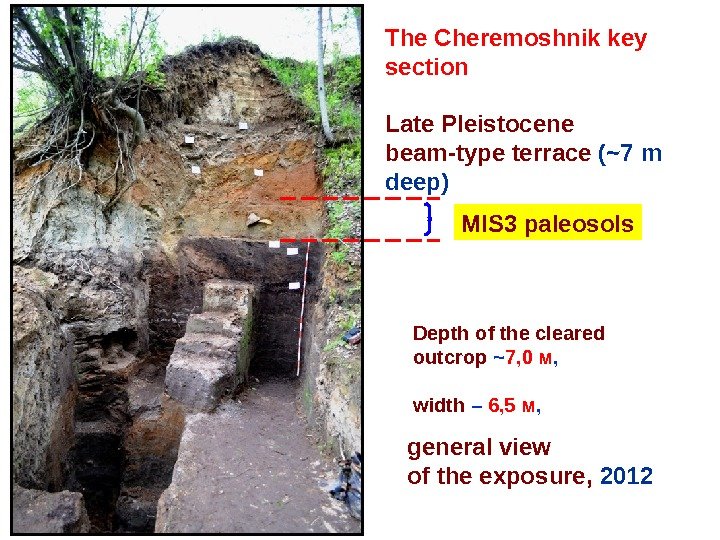

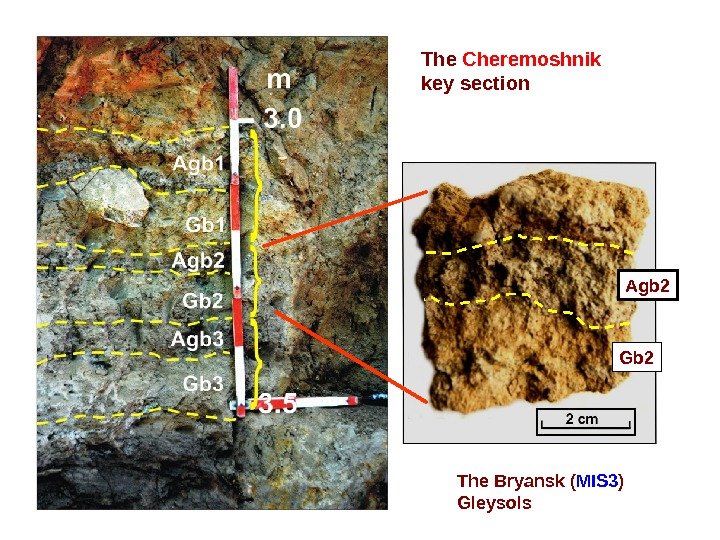
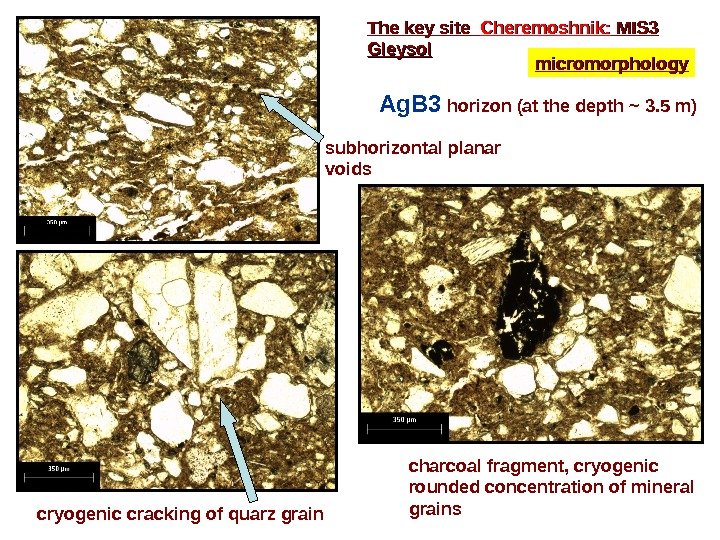
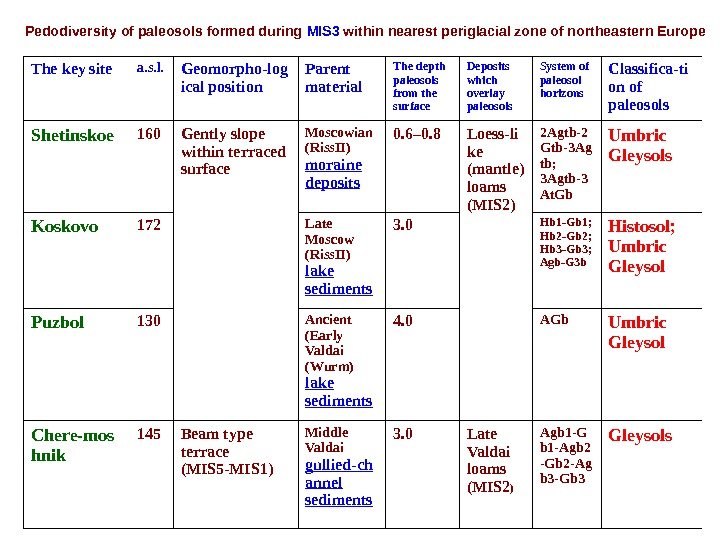
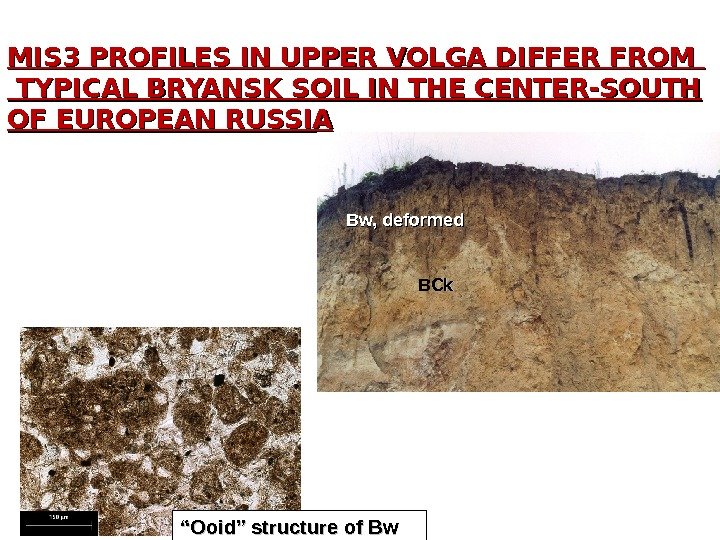
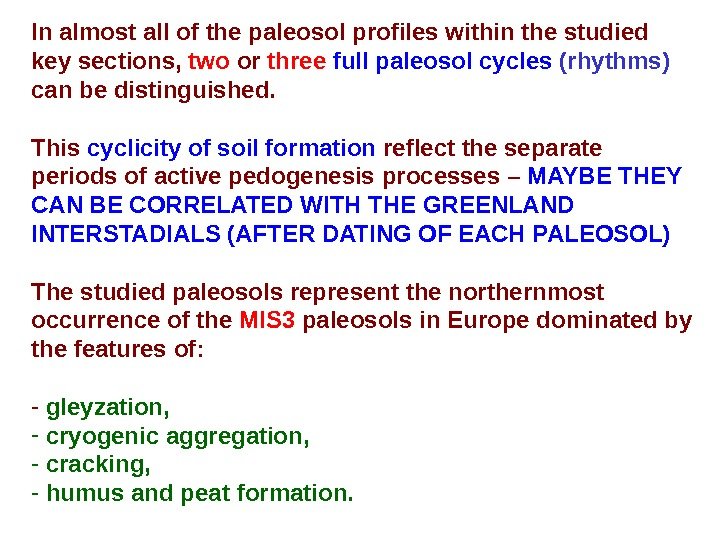

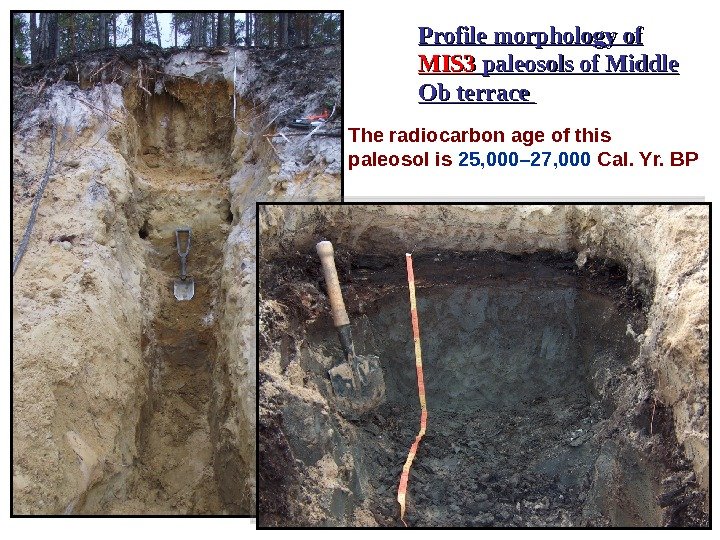

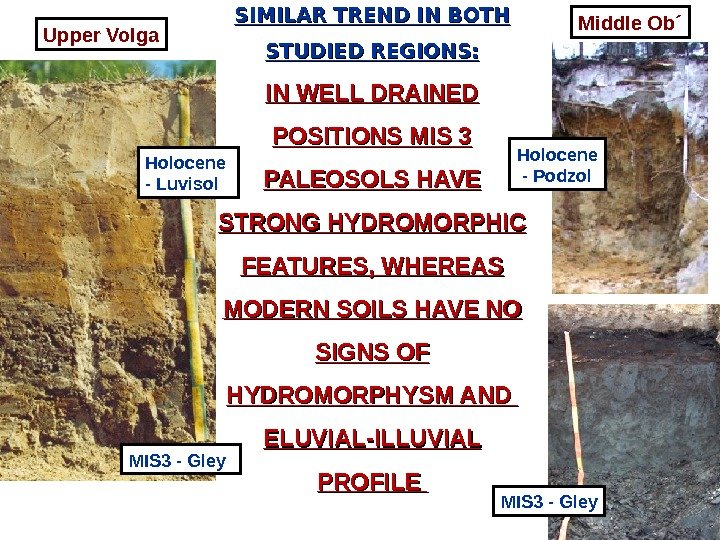
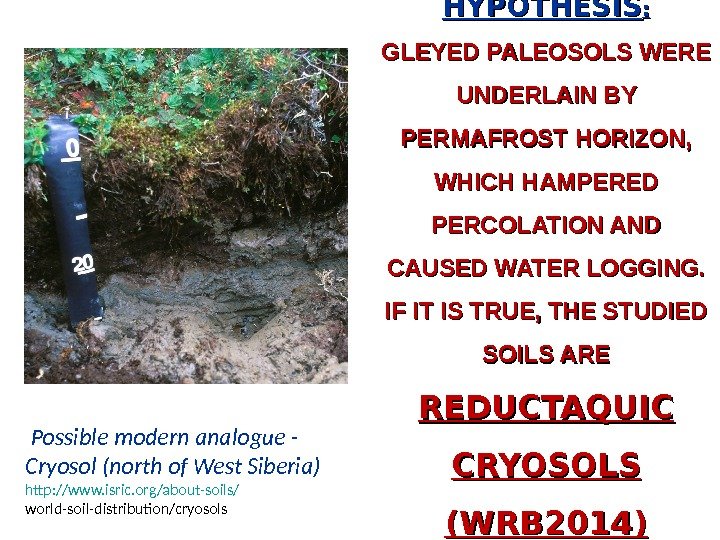
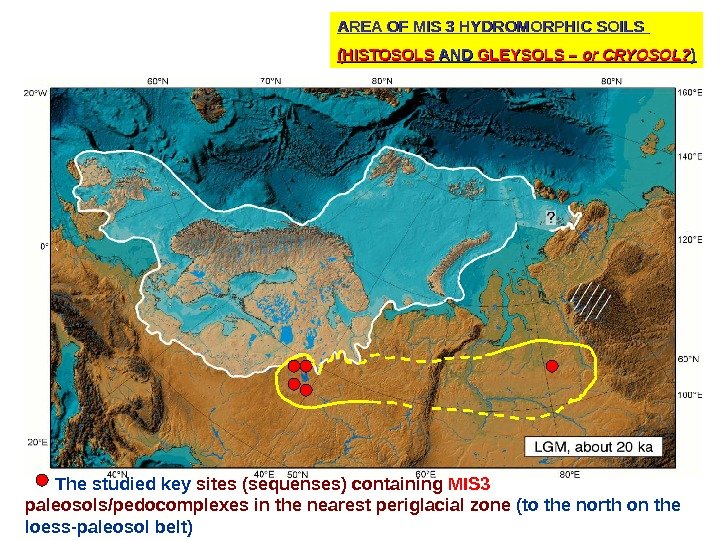
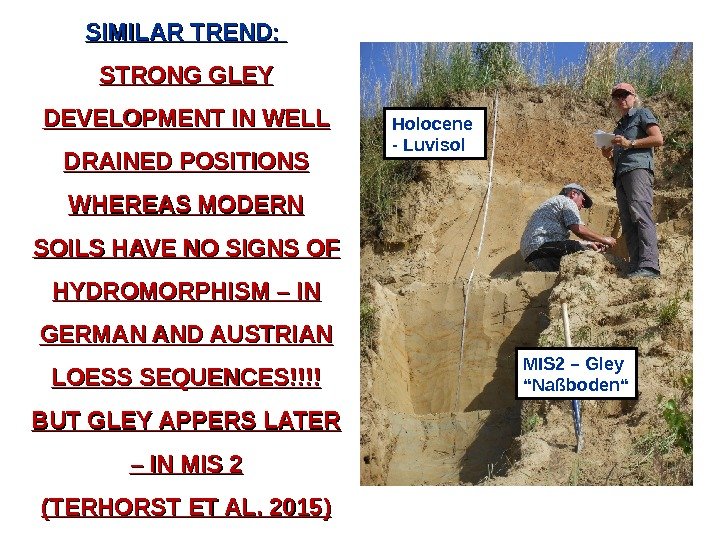

sedov_rusakov_sheinkman_viena-2015_last.ppt
- Размер: 37.6 Мб
- Автор:
- Количество слайдов: 33
Описание презентации MIS 3 Gleysols and Histosols in the center-north по слайдам
 MIS 3 Gleysols and Histosols in the center-north of Eastern Europe and Western Siberia: a latitudinal zone of hydromorphic pedogenesis? Sergey Sedov Departamento de Edafología, Instituto de Geología, UNAM; Mexico; Tyumen State Oil and Gas University Russia Alexey Rusakov Institute of Earth Sciences, Saint-Petersburg State University, Russia Vladimir Sheinkman Tyumen State Oil and Gas University Russia; Earth Cryosphere Institute, RAS, Siberian Branch; Russia the DAN H. YAALON SYMPOSIUM 2015 Vienna, Austria April, 8 th-11 th,
MIS 3 Gleysols and Histosols in the center-north of Eastern Europe and Western Siberia: a latitudinal zone of hydromorphic pedogenesis? Sergey Sedov Departamento de Edafología, Instituto de Geología, UNAM; Mexico; Tyumen State Oil and Gas University Russia Alexey Rusakov Institute of Earth Sciences, Saint-Petersburg State University, Russia Vladimir Sheinkman Tyumen State Oil and Gas University Russia; Earth Cryosphere Institute, RAS, Siberian Branch; Russia the DAN H. YAALON SYMPOSIUM 2015 Vienna, Austria April, 8 th-11 th,
 MARINE OXYGEN ISOTOPE STAGE 3 3 (MIS 3) : global records GENERAL CLIMATIC TREND: MARINE OXYGEN-ISOTOPE STAGES DETAILED RECORD: GREENLAND ICE CORES MIS
MARINE OXYGEN ISOTOPE STAGE 3 3 (MIS 3) : global records GENERAL CLIMATIC TREND: MARINE OXYGEN-ISOTOPE STAGES DETAILED RECORD: GREENLAND ICE CORES MIS
 PALEOSOLS – IMPORTANT TERRESTRIAL PROXY FOR MIS 3 The MIS 3 paleosol units comprise a prominent element of the loess-paleosol sequences throughout the Eurasian Loess Belt.
PALEOSOLS – IMPORTANT TERRESTRIAL PROXY FOR MIS 3 The MIS 3 paleosol units comprise a prominent element of the loess-paleosol sequences throughout the Eurasian Loess Belt.
 MIS 3 IN THE THE LOESS-PALEOSOL SEQUENCES IN THE WATERSHED POSITIONS: 1 -2 “MIDDLE PLENIGLACIAL PALEOSOLS” Germany – – Lohne Boden, Böckinger Boden Austria – Stillfried B paleosol Czechia – – PKI pedocomplex Poland — — Gi/LMd (Komorniki) paleosol Ukraine — — Vytachiv Unit European Russia – – Bryansk Soil Western Siberia – – Iskitim Unit
MIS 3 IN THE THE LOESS-PALEOSOL SEQUENCES IN THE WATERSHED POSITIONS: 1 -2 “MIDDLE PLENIGLACIAL PALEOSOLS” Germany – – Lohne Boden, Böckinger Boden Austria – Stillfried B paleosol Czechia – – PKI pedocomplex Poland — — Gi/LMd (Komorniki) paleosol Ukraine — — Vytachiv Unit European Russia – – Bryansk Soil Western Siberia – – Iskitim Unit
 A reconstruction of the Eurasian ice sheets at the Late Weichselian glacial maximum ( LGM ) ( Svendsen et al. , 2004) The studied key sites (sequenses) containing MIS 3 paleosols / pedocomplexes in the nearest periglacial zone (to the north on the loess-paleosol belt)
A reconstruction of the Eurasian ice sheets at the Late Weichselian glacial maximum ( LGM ) ( Svendsen et al. , 2004) The studied key sites (sequenses) containing MIS 3 paleosols / pedocomplexes in the nearest periglacial zone (to the north on the loess-paleosol belt)
 Location of the studied sections containing MIS 3 paleosols in the East European loess region. 1—Upper Pleistocene loess, 2— Upper and Middle Pleistocene loess, 3— Upper, Middle and Lower Pleistocene loess, 4—Middle and Lower Pleistocene loess, 5— Submerged Pleistocene loess, 6— sections, 7– 11—Ice sheets limits: 7 —Valdai, 8—Moscow, 9—Dnieper, 10—Oka, 11—Don. UPPER VOLGA: NORTHERNMOST FINDING OF BRYANSK SOIL ANALOGUE I-st investigated area
Location of the studied sections containing MIS 3 paleosols in the East European loess region. 1—Upper Pleistocene loess, 2— Upper and Middle Pleistocene loess, 3— Upper, Middle and Lower Pleistocene loess, 4—Middle and Lower Pleistocene loess, 5— Submerged Pleistocene loess, 6— sections, 7– 11—Ice sheets limits: 7 —Valdai, 8—Moscow, 9—Dnieper, 10—Oka, 11—Don. UPPER VOLGA: NORTHERNMOST FINDING OF BRYANSK SOIL ANALOGUE I-st investigated area
 The fragment of the soil cover reconstruction of the Bryansk Interval (MIS 3) within the East-European Plain (A. Velichko & oth. , 2002) 1. Cryogenic Gley Soils with Umbric Gley Cryogenic Soils (having Bca hor. ) 2. Umbric Gley Cryogenic Soils (having Bca hor. ) with Umbric Cryogenic Soils 3. Cryogenic Soils on sands with Umbric Gley Cryogenic Soils (having Bca hor. ) on loess 4 a. Water area 4 b. Area outside reconstruction 4 г. Studied Soil Profiles The studied sequences
The fragment of the soil cover reconstruction of the Bryansk Interval (MIS 3) within the East-European Plain (A. Velichko & oth. , 2002) 1. Cryogenic Gley Soils with Umbric Gley Cryogenic Soils (having Bca hor. ) 2. Umbric Gley Cryogenic Soils (having Bca hor. ) with Umbric Cryogenic Soils 3. Cryogenic Soils on sands with Umbric Gley Cryogenic Soils (having Bca hor. ) on loess 4 a. Water area 4 b. Area outside reconstruction 4 г. Studied Soil Profiles The studied sequences
 The key site Shetinskoe ( northernmost occurrence of the Bryansk fossil soil (MIS 3 stage) of Europe 1 2 m. Wurmian loess-like loams Layer I Riss moraine loams Layer II Riss moraine loams enriched with coarse material Layer III
The key site Shetinskoe ( northernmost occurrence of the Bryansk fossil soil (MIS 3 stage) of Europe 1 2 m. Wurmian loess-like loams Layer I Riss moraine loams Layer II Riss moraine loams enriched with coarse material Layer III
 The key site Schetinskoe : MIS 3 Umbric Gleysol at the base of Holocene Albeluvisol (Catena 71, 2007) The 14 C age of the paleosol humus varied between 28, 800 -35, 600 cal yr BP
The key site Schetinskoe : MIS 3 Umbric Gleysol at the base of Holocene Albeluvisol (Catena 71, 2007) The 14 C age of the paleosol humus varied between 28, 800 -35, 600 cal yr BP
 plane polarized lightsmall charcoal fragments, incorporated in the matrix ferruginous nodule of specific shape, not found in the overlying horizonsplanar voids. Profile Schetinskoe : : MIS 3 Gleysol at the base of Holocene Albeluvisol (Catena 71, 2007)
plane polarized lightsmall charcoal fragments, incorporated in the matrix ferruginous nodule of specific shape, not found in the overlying horizonsplanar voids. Profile Schetinskoe : : MIS 3 Gleysol at the base of Holocene Albeluvisol (Catena 71, 2007)
 The key site Koskovo: MIS 3 Umbric Gleysol at the base of Holocene Albeluvisol (QI 265, 2012) The 14 C age of the paleosol humus and peat varied between 50, 300 — 3 7 , 0 00 cal. BP Agb Gb
The key site Koskovo: MIS 3 Umbric Gleysol at the base of Holocene Albeluvisol (QI 265, 2012) The 14 C age of the paleosol humus and peat varied between 50, 300 — 3 7 , 0 00 cal. BP Agb Gb
 The key site Koskovo The general view of the exposure, 2014 Hb 1, Agb Hb 2 Hb 3 Rhythms of paleopedogenesis 1 st 3 d 2 ndм 0, 5 1, 0 1,
The key site Koskovo The general view of the exposure, 2014 Hb 1, Agb Hb 2 Hb 3 Rhythms of paleopedogenesis 1 st 3 d 2 ndм 0, 5 1, 0 1,
 The key site Koskovo The exposure, 2014 Surface: vertical horizontal MIS 3 paleosols MIS 3 paleosol ( Hb, Gb horizons ) incorporated in the cryogenic wedge
The key site Koskovo The exposure, 2014 Surface: vertical horizontal MIS 3 paleosols MIS 3 paleosol ( Hb, Gb horizons ) incorporated in the cryogenic wedge
 The key site Koskovo The exposure, 2014 Horizontal clearance : Rhythms of paleopedogenesis 3 d (upper) 2 nd (middle) The visible relict of a cryogenic polygonal microrelief
The key site Koskovo The exposure, 2014 Horizontal clearance : Rhythms of paleopedogenesis 3 d (upper) 2 nd (middle) The visible relict of a cryogenic polygonal microrelief
 The key site Koskovo The exposure, 2014 Horizontal clearance rhythm of paleopedogenesis 2 nd (middle) Hb horizons Gb horizons Mesomorphology
The key site Koskovo The exposure, 2014 Horizontal clearance rhythm of paleopedogenesis 2 nd (middle) Hb horizons Gb horizons Mesomorphology
 Profile Koskovo: micromorphology ofof Hb Hb andand Gb Gb horizons Fe-Mn pedofeatures. Plant detrite
Profile Koskovo: micromorphology ofof Hb Hb andand Gb Gb horizons Fe-Mn pedofeatures. Plant detrite
 The key site Puzbol: MIS 3 Umbric Gleysol at the base of Holocene Albeluvisol (QI 265, 2012) The 14 C age of the paleosol humus and peat is 39 , 7 00 cal. BP
The key site Puzbol: MIS 3 Umbric Gleysol at the base of Holocene Albeluvisol (QI 265, 2012) The 14 C age of the paleosol humus and peat is 39 , 7 00 cal. BP
 The key site Puzbol: MIS 3 Gleysol at the base of Holocene Albeluvisol (QI 265, 2012) Ferruginous pedofeature, broken and displaced along the fissure. DG 2 horizon 315 -355 cm Concentric nodule with alternating iron and clay ringsmicromorphology
The key site Puzbol: MIS 3 Gleysol at the base of Holocene Albeluvisol (QI 265, 2012) Ferruginous pedofeature, broken and displaced along the fissure. DG 2 horizon 315 -355 cm Concentric nodule with alternating iron and clay ringsmicromorphology
 Depth of the cleared outcrop ~ 7, 0 м , w idth – 6, 5 м , general view of the exposure, 2012 The Cheremoshnik key section Late Pleistocene beam-type terrace (~7 m deep) MIS 3 paleosols
Depth of the cleared outcrop ~ 7, 0 м , w idth – 6, 5 м , general view of the exposure, 2012 The Cheremoshnik key section Late Pleistocene beam-type terrace (~7 m deep) MIS 3 paleosols
 Chronostratigraphy, morphology and some properties of soil- sedimentary strata of the Cheremoshnik key section. The Bryansk paleosol ( MIS 3 ) Sum of Agb 2 and Agb 3 horizons The 14 C age is 27 , 480± 560 cal yr BP
Chronostratigraphy, morphology and some properties of soil- sedimentary strata of the Cheremoshnik key section. The Bryansk paleosol ( MIS 3 ) Sum of Agb 2 and Agb 3 horizons The 14 C age is 27 , 480± 560 cal yr BP
 The Cheremoshnik key section Agb 2 Gb 2 The Bryansk ( MIS 3 ) Gleysols
The Cheremoshnik key section Agb 2 Gb 2 The Bryansk ( MIS 3 ) Gleysols
 The key site Cheremoshnik: MIS 3 Gleysol micromorphology Ag. B 3 horizon (at the depth ~ 3. 5 m) subhorizontal planar voids cryogenic cracking of quarz grain charcoal fragment, cryogenic rounded concentration of mineral grains
The key site Cheremoshnik: MIS 3 Gleysol micromorphology Ag. B 3 horizon (at the depth ~ 3. 5 m) subhorizontal planar voids cryogenic cracking of quarz grain charcoal fragment, cryogenic rounded concentration of mineral grains
 The key site a. s. l. Geomorpho-log ical position Parent material The depth paleosols from the surface Deposits which overlay paleosols System of paleosol horizons Classifica-ti on of paleosols Shetinskoe 160 Gently slope within terraced surface Moscowian (Riss. II) moraine deposits 0. 6– 0. 8 Loess-li ke (mantle) loams (MIS 2) 2 Agtb-2 Gtb-3 Ag tb; 3 Agtb-3 At. Gb Umbric Gleysols Koskovo 172 Late Moscow (Riss. II) lake sediments 3. 0 Hb 1 -Gb 1; Hb 2 -Gb 2; Hb 3 -Gb 3; Agb-G 3 b Histosol; Umbric Gleysol Puzbol 130 Ancient (Early Valdai (Wurm) lake sediments 4. 0 AGb Umbric Gleysol Chere — mos hnik 145 Beam type terrace (MIS 5 -MIS 1) Middle Valdai gullied-ch annel sediments 3. 0 Late Valdai loams (MIS 2 ) Agb 1 -G b 1 -Agb 2 -Gb 2 -Ag b 3 -Gb 3 Gleysols. Pedodiversity of paleosols formed during MIS 3 within nearest periglacial zone of northeastern Europe
The key site a. s. l. Geomorpho-log ical position Parent material The depth paleosols from the surface Deposits which overlay paleosols System of paleosol horizons Classifica-ti on of paleosols Shetinskoe 160 Gently slope within terraced surface Moscowian (Riss. II) moraine deposits 0. 6– 0. 8 Loess-li ke (mantle) loams (MIS 2) 2 Agtb-2 Gtb-3 Ag tb; 3 Agtb-3 At. Gb Umbric Gleysols Koskovo 172 Late Moscow (Riss. II) lake sediments 3. 0 Hb 1 -Gb 1; Hb 2 -Gb 2; Hb 3 -Gb 3; Agb-G 3 b Histosol; Umbric Gleysol Puzbol 130 Ancient (Early Valdai (Wurm) lake sediments 4. 0 AGb Umbric Gleysol Chere — mos hnik 145 Beam type terrace (MIS 5 -MIS 1) Middle Valdai gullied-ch annel sediments 3. 0 Late Valdai loams (MIS 2 ) Agb 1 -G b 1 -Agb 2 -Gb 2 -Ag b 3 -Gb 3 Gleysols. Pedodiversity of paleosols formed during MIS 3 within nearest periglacial zone of northeastern Europe
 MIS 3 PROFILES IN UPPER VOLGA DIFFER FROM TYPICAL BRYANSK SOIL IN THE CENTER-SOUTH OF EUROPEAN RUSSIA ““ Ooid” structure of Bw Bw, deformed BCk
MIS 3 PROFILES IN UPPER VOLGA DIFFER FROM TYPICAL BRYANSK SOIL IN THE CENTER-SOUTH OF EUROPEAN RUSSIA ““ Ooid” structure of Bw Bw, deformed BCk
 In almost all of the paleosol profiles within the studied key sections, two or three full paleosol cycles (rhythms) can be distinguished. This cyclicity of soil formation reflect the separate periods of active pedogenesis processes – MAYBE THEY CAN BE CORRELATED WITH THE GREENLAND INTERSTADIALS (AFTER DATING OF EACH PALEOSOL) Th e studied paleosols represent the northernmost occurrence of the MIS 3 paleosols in Europe dominated by the features of : — gleyzation, — cryogenic aggregation, — cracking, — humus and peat formation. Clay coatings in the Middle Valday paleosols and pedosediments are products of Holocene pedogenesis.
In almost all of the paleosol profiles within the studied key sections, two or three full paleosol cycles (rhythms) can be distinguished. This cyclicity of soil formation reflect the separate periods of active pedogenesis processes – MAYBE THEY CAN BE CORRELATED WITH THE GREENLAND INTERSTADIALS (AFTER DATING OF EACH PALEOSOL) Th e studied paleosols represent the northernmost occurrence of the MIS 3 paleosols in Europe dominated by the features of : — gleyzation, — cryogenic aggregation, — cracking, — humus and peat formation. Clay coatings in the Middle Valday paleosols and pedosediments are products of Holocene pedogenesis.
 WEST SIBERIA: FIRST FINDINGS OF MIS 3 PALEOSOLS 2 -nd investigated area
WEST SIBERIA: FIRST FINDINGS OF MIS 3 PALEOSOLS 2 -nd investigated area
 Profile morphology of MIS 3 paleosols of Middle Ob terrace The radiocarbon age of this paleosol is 25, 000– 27, 000 Cal. Yr. BP
Profile morphology of MIS 3 paleosols of Middle Ob terrace The radiocarbon age of this paleosol is 25, 000– 27, 000 Cal. Yr. BP
 Micromorphology of MIS 3 paleosols of Middle Ob terrace — similar to Histosols and Gleysols of Upper Volga
Micromorphology of MIS 3 paleosols of Middle Ob terrace — similar to Histosols and Gleysols of Upper Volga
 SIMILAR TREND IN BOTH STUDIED REGIONS: IN WELL DRAINED POSITIONS MIS 3 PALEOSOLS HAVE STRONG HYDROMORPHIC FEATURES, WHEREAS MODERN SOILS HAVE NO SIGNS OF HYDROMORPHYSM AND ELUVIAL-ILLUVIAL PROFILE Upper Volga Holocene — Luvisol MIS 3 — Gley Middle Ob´ Holocene — Podzol MIS 3 — Gley
SIMILAR TREND IN BOTH STUDIED REGIONS: IN WELL DRAINED POSITIONS MIS 3 PALEOSOLS HAVE STRONG HYDROMORPHIC FEATURES, WHEREAS MODERN SOILS HAVE NO SIGNS OF HYDROMORPHYSM AND ELUVIAL-ILLUVIAL PROFILE Upper Volga Holocene — Luvisol MIS 3 — Gley Middle Ob´ Holocene — Podzol MIS 3 — Gley
 Possible modern analogue — Cryosol (north of West Siberia) http: //www. isric. org/about-soils/ world-soil-distribution/cryosols HYPOTHESIS : : GLEYED PALEOSOLS WERE UNDERLAIN BY PERMAFROST HORIZON, WHICH HAMPERED PERCOLATION AND CAUSED WATER LOGGING. IF IT IS TRUE, THE STUDIED SOILS ARE REDUCTAQUIC CRYOSOLS (WRB 2014)
Possible modern analogue — Cryosol (north of West Siberia) http: //www. isric. org/about-soils/ world-soil-distribution/cryosols HYPOTHESIS : : GLEYED PALEOSOLS WERE UNDERLAIN BY PERMAFROST HORIZON, WHICH HAMPERED PERCOLATION AND CAUSED WATER LOGGING. IF IT IS TRUE, THE STUDIED SOILS ARE REDUCTAQUIC CRYOSOLS (WRB 2014)
 The studied key sites (sequenses) containing MIS 3 paleosols / pedocomplexes in the nearest periglacial zone (to the north on the loess-paleosol belt) AREA OF MIS 3 HYDROMORPHIC SOILS (HISTOSOLS AND GLEYSOLS – or CRYOSOL? ))
The studied key sites (sequenses) containing MIS 3 paleosols / pedocomplexes in the nearest periglacial zone (to the north on the loess-paleosol belt) AREA OF MIS 3 HYDROMORPHIC SOILS (HISTOSOLS AND GLEYSOLS – or CRYOSOL? ))
 SIMILAR TREND: STRONG GLEY DEVELOPMENT IN WELL DRAINED POSITIONS WHEREAS MODERN SOILS HAVE NO SIGNS OF HYDROMORPHISM – IN GERMAN AND AUSTRIAN LOESS SEQUENCES!!!! BUT GLEY APPERS LATER – IN MIS 2 (TERHORST ET AL. 2015) Holocene — Luvisol MIS 2 – Gley “ Naßboden“
SIMILAR TREND: STRONG GLEY DEVELOPMENT IN WELL DRAINED POSITIONS WHEREAS MODERN SOILS HAVE NO SIGNS OF HYDROMORPHISM – IN GERMAN AND AUSTRIAN LOESS SEQUENCES!!!! BUT GLEY APPERS LATER – IN MIS 2 (TERHORST ET AL. 2015) Holocene — Luvisol MIS 2 – Gley “ Naßboden“


